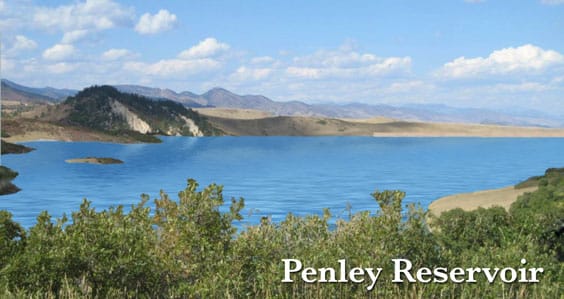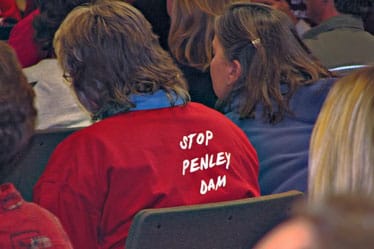Water Storage on the Horizon?

Douglas County residents have an additional opportunity to weigh in on the proposed Penley Reservoir at an upcoming January 10 Use by Special Review hearing, which was continued from December for additional public comment. The proposed reservoir is part of the Penley Ranch project, located south of C-470 and west of Sedalia and US Highway 85. Neighboring residents are rallying in opposition of the proposed reservoir.
Article by Elizabeth Wood West with photos by Terri Wiebold
Douglas County may soon have a new reservoir to complement its ongoing efforts to develop sustainable and renewable water resources for county residents, but it won’t come without opposition from some.
The proposed non-recreational Penley Reservoir is a Use by Special Review application and part of the Penley Ranch project. Penley Ranch is a 1,215-acre proposed rural residential development with plans for development of not-smaller-than 35-acre lots. The development and the proposed reservoir are located south of C-470 a few miles west of Sedalia and US Highway 85.
Penley Ranch developers Darwin Horan and Chris Fellows submitted the reservoir application in March 2010, which included two options:
Option A – 24,000 acre-foot reservoir on about 430 acres; and
Option B – 14,500 acre-foot reservoir on about 292 acres.
By comparison, the Rueter-Hess Reservoir (recently approved by both the Douglas County Planning Commission and the Board of County Commissions and currently under construction in Parker) will provide up to 72,000 acre-feet of storage on 1,170 acres.
The application is currently under review by the Douglas County Planning Commission. County planning staff has recommended approval of both options for the reservoir, leaving the final option choice to the developers.
Staff’s recommendation for approval was based on the application’s compliance with the county’s criteria, zoning regulations, and, most significantly, its 2030 Master Plan: “Encourage water providers, developers, residents, and elected officials to support efforts to provide sustainable water supplies and promote groundwater conservation.”
Staff further noted that the proposed reservoir would offer much-needed water storage for area water providers.
The need for water storage
Castle Pines resident Mark Shively, who is the executive director and former president of the Douglas County Water Resource Authority, had this to contribute: “There is no doubt more storage is needed to support water supplies and offset impacts of climate change on existing storage.” He continued, “Nowhere are these words more true than in northwest Douglas County, the location of Penley.” Shively went on to share his personal opinions, stating, “We should support consideration of bona fide storage locations. Penley may be one such option.”
With area aquifers rapidly dropping, local municipalities and metropolitan districts have identified the need for renewable water solutions.
The Castle Pines North Metropolitan District (CPNMD) board of directors and staff agree that acquiring renewable water resources [water supply, water transportation, water storage, and water treatment] is a top priority for the district, according to Board President Steve Labossiere.
Castle Pines Metropolitan District Chairman Joe Gschwendtner noted that water storage is a basic and critical factor in supplying water to metropolitan districts. “As a district, we are acutely interested in all water storage opportunities,” said Gschwendtner.
The key component to diverting and delivering renewable water to a community is storage, according to James McGrady, utility director for the City of Castle Pines and former manager of the CPNMD and senior water resource engineer for Colorado Springs Utilities and Aurora Water. “Given the many supply options available to deliver renewable water to Douglas County, perhaps the single most important component that will be needed in the future is terminal reservoir storage,” stated McGrady.
A viable solution, but at what cost?
More than 250 area residents attended the Douglas County Use by Special Review hearing in December. Nearly a third of the audience donned red t-shirts that read “I may live in the death zone of Penley Dam” on the front and “Stop Penley Dam” on the back to show their opposition to the proposed reservoir. Many in attendance were representing the Stop Penley Dam (SPD) coalition.
Area neighbors, businesses, and Indian Creek Ranch residents who live adjacent to Penley Ranch formed the coalition. SPD has raised concerns regarding safety, as well as impacts to property values, view sheds, quality of life, historical preservation, and wildlife protection.
SPD Chairwoman Veronica New stated, “I believe we all have a variety of concerns surrounding the Penley Dam, but leading the list of concerns is the safety of our families, neighbors and properties that are in the destruction path in the event of a dam failure. That destruction path would devastate the Indian Creek Ranch community and could extend through to other homes, businesses and communities down West Plum Creek alongside US 85,” stated New.
Additional commenting parties included the West Douglas County Fire Protection District and the Thunderbird Water and Sanitation District (TWSD), which currently serve the Indian Creek Ranch subdivision.
West Douglas County Fire Protection District submitted a referral letter indicating it had no training or equipment for water rescue, as well as addressing the need to build an access road from Highway 67 to the new station 3.
In a letter to Douglas County Chief Planner Curt Weitkunat, the treasurer of the TWSD wrote, “Thunderbird Water and Sanitation District has numerous concerns about allowing a Use by Special Review for either option of the proposed project.” The letter continued, “TWSD agrees that ‘Sustainable water is imperative to the future of Douglas County’ and that water storage facilities are an indispensible part of the effort to develop such supplies. But such facilities should not be considered where a specific landowner and the county-at-large profits at the considerable expense of the residents and water district immediately adjacent and downhill from such facilities.”
To read the letter in its entirety, as well as other comments from those in opposition to the project, visit http://stoppenleydam.com/.
According to Fellows, who presented on behalf of the applicant at the hearing, “We have gone to great lengths to address and alleviate the concerns of surrounding residents and entities,” he said. “Out of respect for the quasi-judicial and quasi-legislative nature of this issue, we defer comment and encourage interested parties to refer to the comprehensive staff report submitted by the county.” (see www.douglas.co.us/meetingsandagendas/documents/US2010-006_000.pdf.)
Moving forward
Along with obtaining county approval and various permits, the reservoir will need to meet strict regulations from the Colorado Division of Water Resources-State Engineer’s Office, the Army Corps of Engineers, Colorado Water Court, U.S. Fish and Wildlife Service, and the Colorado Division of Wildlife.
According to Shively, “If the application is successful, next steps include rigorous examination of dam safety issues. These studies are expensive, and can take years to perform. While we have a private sector entity willing to risk their money to conduct the required studies, we should let them. The results don’t always work out the way an applicant hopes,” he said. “The State Engineer’s Office is not going to allow the Penley project to go forward if the location is determined to be unsafe.”
New said, “We hope to convince the Douglas County Planning Commission members to not recommend the approval of this project. We all understand the need for water storage; however, this is not the right place for it.”
The Planning Commission public hearing for Penley Reservoir has been continued to January 10 at 7 p.m. in the Commissioner’s hearing room, located at 100 Third Street in Castle Rock. For more information about the hearing, contact Douglas County planning staff at 303-660-7460.
